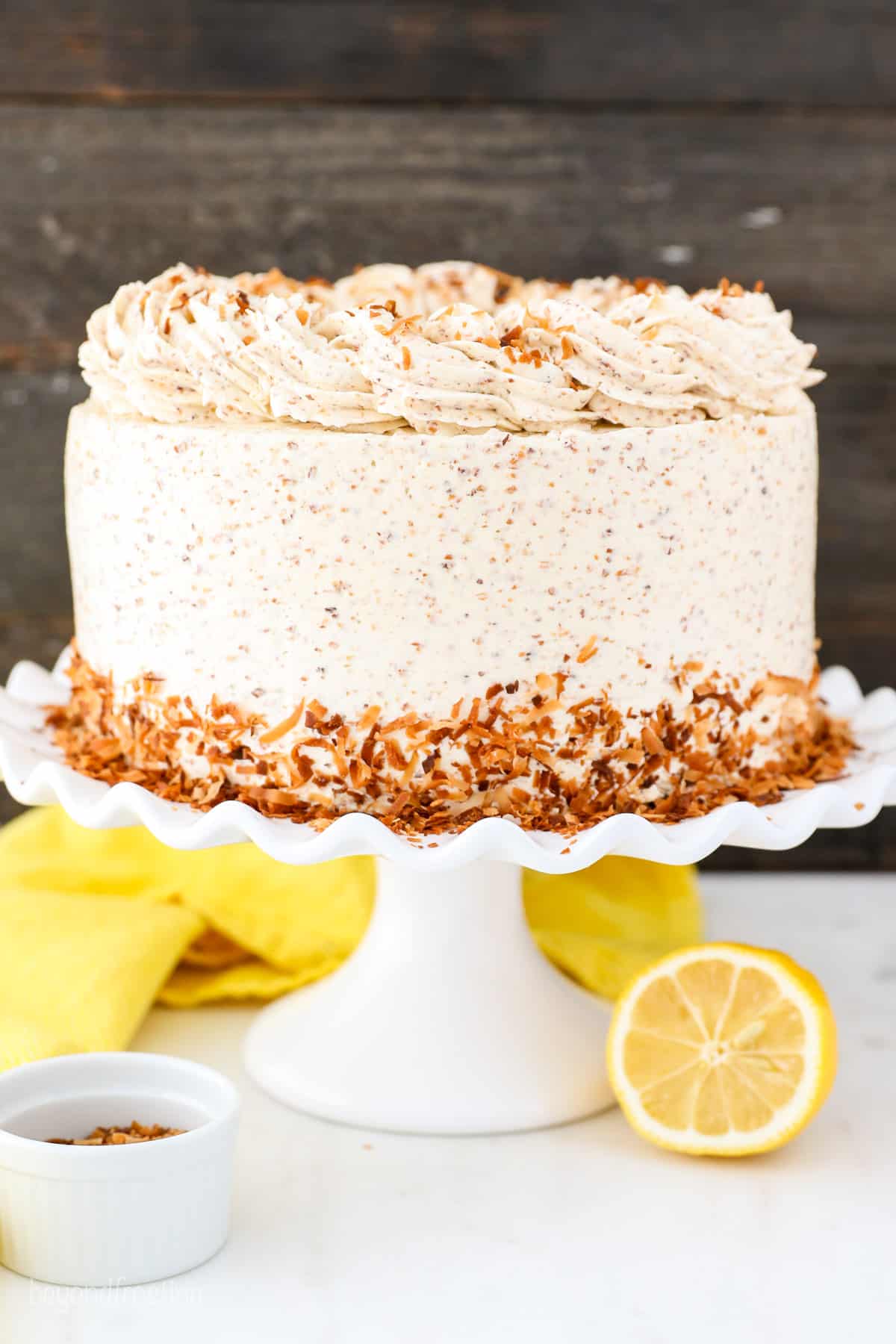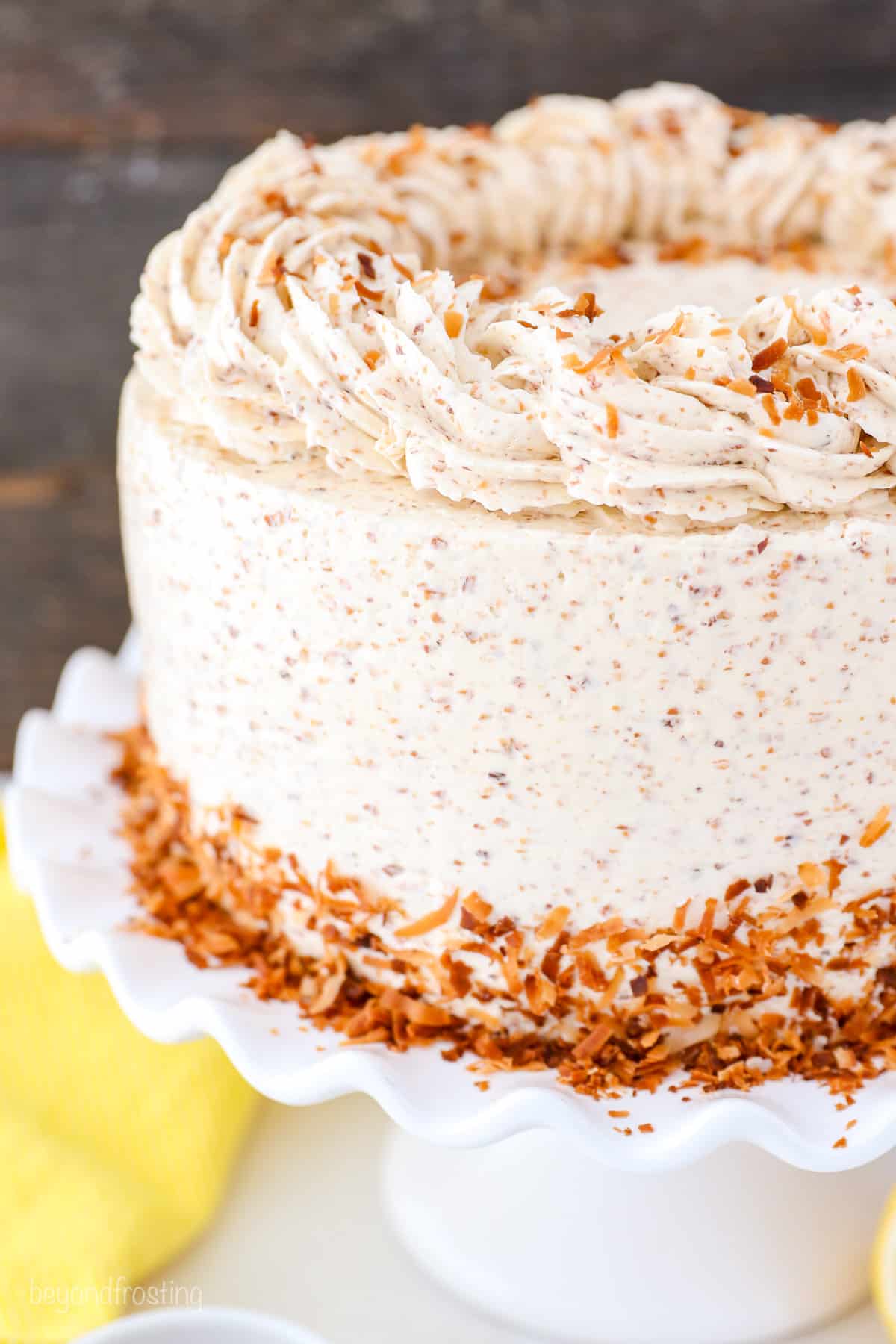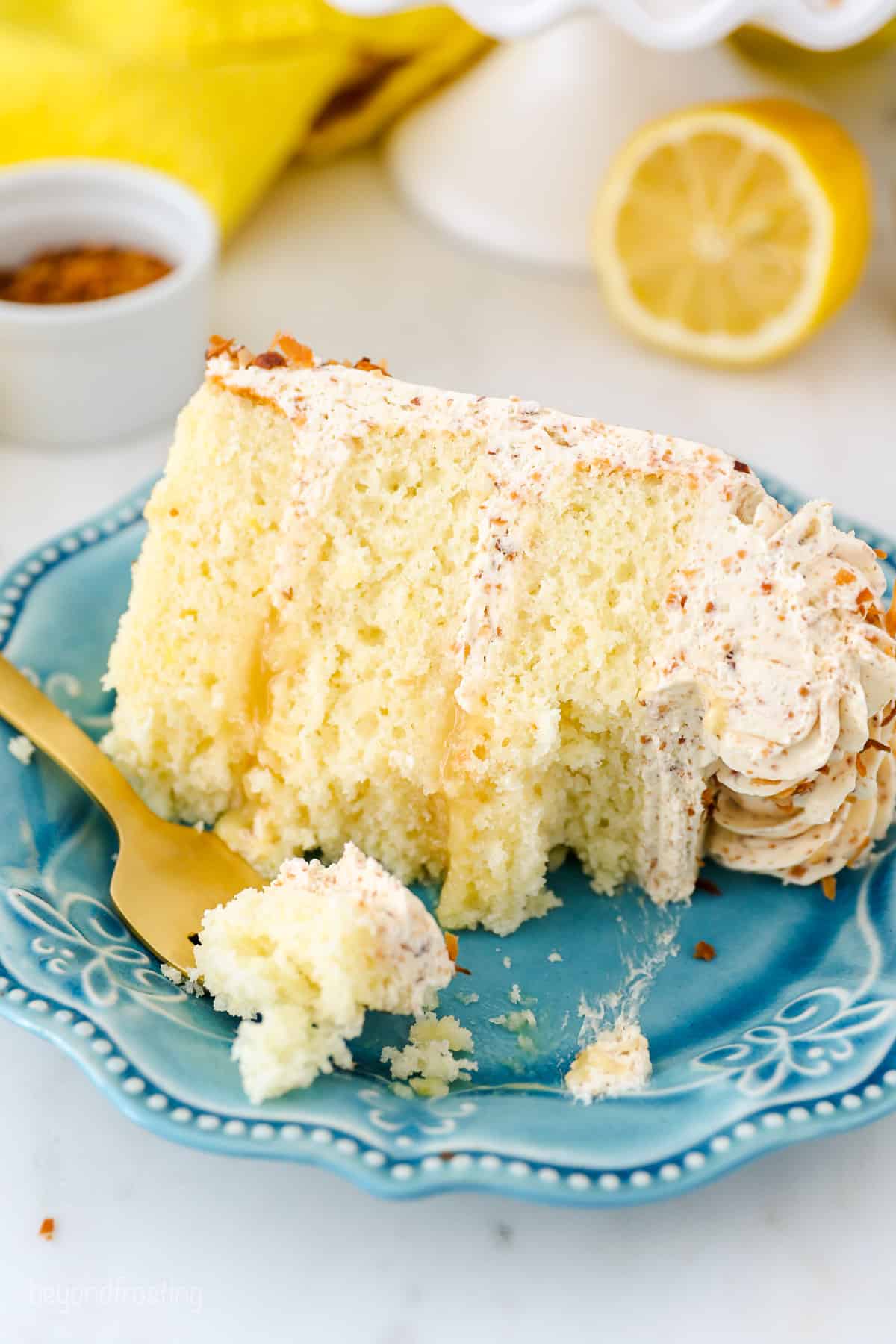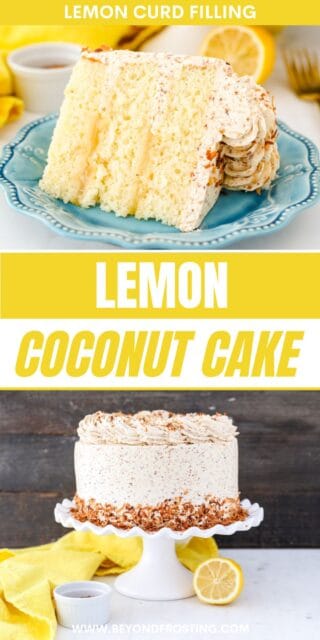This post may contain affiliate sales links. Please see my full disclosure policy for details
This rich and moist lemon coconut cake is an easy lemon cake layered with silky lemon curd, finished with buttery toasted coconut frosting. It’s perfect for spring baking and so dreamy!

Easy and Moist Lemon Coconut Cake
This lemon coconut cake is a moist lemon layer cake filled with tangy lemon curd and frosted with rich and creamy toasted coconut meringue. And if that doesn’t have your mouth watering already, just wait until you get a whiff of this cake baking in the oven.
Warm, fresh lemon, followed by sweet and toasty coconut. Everything gets combined into a decadent layer cake smothered in the silkiest frosting ever. If you’re looking for an easy but impressive cake recipe to make for Easter, this lemon coconut cake is a must-try!
Why You’ll Love It
- Soft, moist cake. This lemon coconut cake is like a cross between my lemon curd cake and these buttery coconut cupcakes. It has soft, fluffy lemon buttermilk cake bursting with silky lemon curd, finished off with coconut.
- Bright lemon flavor. I make this cake with real lemon zest and lemon juice, with a touch of lemon extract to brighten things up. The flavors are rich, tangy, and not too sweet.
- Toasted coconut buttercream. If you’re not familiar with Swiss meringue buttercream, prepare to fall in love with the frosting for this cake. Infused with nutty toasted coconut, the meringue frosting is so light and airy that every bite melts in your mouth.
- Quick to make. The batter is oil-based and comes together quickly. It always turns out extra tender!

Ingredient Notes
Here are some notes on the ingredients you’ll need for this lemon cake with coconut frosting. Scroll down to the recipe card for a printable ingredients list.
- Oil – Using vegetable oil (or another neutral oil, like canola) in place of butter makes this lemon cake extra moist.
- Lemon Zest, Juice, and Lemon Extract – You’ll need fresh lemons, zested and squeezed, along with lemon extract to flavor this cake. You can use pure vanilla extract instead of lemon extract if needed.
- Sour Cream – Light or full-fat sour cream. Along with oil, this is my second secret to a perfectly soft, flavorful cake. Don’t skip it! If you don’t have sour cream on hand, use Greek yogurt instead.
- Buttermilk – I love the tanginess and richness of buttermilk in this lemon cake. If you don’t have any on hand, it’s easy enough to make your own, see below.
- Lemon Curd – Use your favorite jar of lemon curd from the store. Or, if you have the time, you can make homemade lemon curd.
- Toasted Coconut – Sweetened toasted coconut flakes, or unsweetened coconut also works. See my tutorial on how to toast coconut (either in the oven or on the stove) and the recipe card for instructions.
- Egg Whites – For this lemon coconut cake, I use a variation of my Swiss meringue buttercream frosting recipe made from egg whites, flavored with toasted coconut and coconut extract. You’ll find the details below and in the recipe card.
What If I Don’t Have Buttermilk?
Not to worry. If you don’t have buttermilk, make an easy homemade buttermilk substitute by combining 1 tablespoon of lemon juice (or vinegar) with enough milk to fill 1 cup. Let the mixture sit for 5 minutes, then stir. It’s ready to use in the recipe as directed.

How to Make a Lemon Coconut Cake
Below is a short step-by-step to walk you through how to make this lemon coconut cake from start to finish, starting with the lemon cake layers. Don’t forget to scroll to the recipe card for printable instructions.
- Make the cake batter. Beat together sugar, oil, eggs, and lemon extract in a bowl, and add the lemon zest and sour cream. Whisk together the dry ingredients separately. Next, alternate adding the dry ingredients to the wet ingredients, along with lemon juice and buttermilk. Be careful not to overmix.
- Bake. Divide the lemon cake batter evenly between three greased and lined 8” round cake pans. Bake at 350ºF for 20-23 minutes, turning the pans about halfway through baking. Let the cakes cool completely once they’re out of the oven.
- Toast the coconut. I like to do this in the oven while it’s still preheated. Spread the shredded coconut out onto a lined baking sheet and bake it at 350ºF for 5-10 minutes. Stir the coconut occasionally and take it out once it starts to turn a light golden brown.
Make the Toasted Coconut Frosting
Next, we’ll make a quick and easy Swiss meringue frosting.
- Heat the meringue ingredients. Start by combining the egg whites and sugar in a double boiler over medium heat. Whisk constantly until the mixture reaches 140°-160°F (a candy thermometer comes in handy here).
- Whip the meringue. Right away, beat the heated egg whites in a stand mixer, slowly at first, gradually increasing the speed to high. Keep beating until the meringue forms stiff peaks.
- Add butter. Next, slowly beat in the butter 1 tablespoon at a time. If your frosting looks a bit curdled at this point, don’t panic. Continue beating as you add the coconut extract. You should see stiff peaks start to form again.
- Finish the frosting. Set aside some of your toasted shredded coconut for decorating the cake, and add the rest to a food processor. Blend the coconut into crumbs, and, finally, fold the crumbs into your frosting.
Assemble the Cake
Lastly, we’ll assemble this lemon coconut cake! If you’re still getting the hang of layer cakes, check out my tutorial on how to make a layer cake with loads of helpful tips.
- Start with the first cake layer. If needed, level the cakes using a cake leveler (or a serrated knife). Place the first cake layer onto a plate or cake board, over top of a dollop of frosting to keep the cake from sliding.
- Add lemon curd and repeat. Use a large piping bag fitted with an open round tip to pipe a dam of frosting around the edge of the cake, preventing the lemon curd from seeping out. Spread a layer of lemon curd to fill the inside. Repeat with the remaining cake layers.
- Add a crumb coat. Using an offset spatula, spread a thin layer of frosting over the outside of the cake to create a crumb coat. Place the whole cake into the fridge to chill for 20 minutes.
- Frost the cake. Frost the top and sides of the cake with your toasted coconut frosting. You can use any leftover frosting to pipe swirls and florets over the top of the cake (I use a large open star piping tip to achieve the designs in the photos). Finally, press toasted coconut around the bottom edges and sprinkle it over top.

Recipe Tips and Variations
Even if you’re new to baking cakes, this recipe is bound to turn out delicious. These are my tips for success along with some simple variations that you can try:
- Prevent the cakes from doming. Bake-even strips are a handy baking tool that wraps around the outside of the cake pans. The strips prevent cakes from baking too quickly at the edges and rising too high in the middle (creating “domes”). Highly recommend!
- Watch the coconut while it bakes. It can take a little bit of time for coconut to start toasting, but once it does, it happens quickly. Don’t venture too far from the oven!
- Let the coconut cool completely. Toast the coconut as soon as your cakes come out of the oven so that it has a chance to cool completely before you add it to the frosting. Your cakes will also need to cool to room temperature before you can fill and frost them.
- Skip toasting the coconut. If you’re in a hurry, or if you prefer the taste, make the frosting using regular shredded coconut instead. I still recommend pulsing the coconut in a food processor first, as it tends to be clumpy and sticky straight out of the package.
- Whip the frosting in a clean bowl. Make sure to start with a clean, dry stainless steel bowl. I recommend wiping down the inside of the bowl with vinegar to remove any grease. Even the slightest bit of grease or moisture can ruin meringue frosting.
- Decorate like a pro. If you’re new to cake decorating, I have in-depth tutorials on how to use a piping bag and how to use piping tips that you can refer to when decorating this cake.
- Try another frosting. If you’d prefer to use another kind of frosting, you can borrow the mascarpone whipped cream from my blueberry lemon mascarpone cake. This coconut whipped cream would be delicious but is not suitable for piping or decorating,

How to Store Lemon Coconut Cake
- To Store. The frosted lemon coconut cake can be stored airtight at room temperature for 1-2 days. After that, I recommend keeping it in the fridge. Take the cake out ahead of serving to let it come to room temperature.
- Freeze. I recommend freezing the lemon cake layers before they’re frosted. Wrap the cake in a double layer of plastic wrap and freeze it for up to 2 months. Defrost in the fridge before frosting and assembling.
More Lemon Cake Recipes
- Easy Lemon Drizzle Cake
- Lemon Raspberry Layer Cake
- Lemon Blackberry Cake
- Easy Lemon Bundt Cake
- Lemon Olive Oil Cake

Lemon Coconut Cake
- Prep Time: 1 hour
- Cook Time: 24 minutes
- Total Time: 1 hour and 24 minutes
- Yield: 10 servings
Description
This easy lemon coconut cake combines moist lemon cake layers with silky lemon curd, finished with buttery toasted coconut frosting. It’s a dreamy cake recipe that’s perfect for spring!
Ingredients
For the Cake:
- 2 cups (380g) granulated sugar
- ½ cup (118 ml) vegetable oil
- 3 large eggs
- 2 lemons- zested and juiced (1/4 cup)
- 1 teaspoon (5ml) Lemon (or vanilla) extract
- ½ cup (118 ml) sour cream
- 2 ½ cups (350 g) all-purpose flour
- 3 teaspoons (11.2 g) baking powder
- 1 teaspoon (5 g) salt
- 1 cup (236 ml) buttermilk (or milk)
- 1/4 cup (59ml) fresh lemon juice
- 10 ounces Lemon Curd, (1 jar)
For the Frosting:
- 2 cups (240g) Sweetened Coconut Flakes, toasted (heaping cups)
- 8 large Egg Whites
- 1 1/2 cups (285g) Granulated Sugar
- 2 1/4 cups (510g) Unsalted Butter
- 1 1/2 teaspoons (7ml) Coconut Extract
Instructions
Make the Cake
- Preheat the oven to 350°F. Prepare three 8-inch round baking pans, line the bottom with parchment paper, and grease the sides.
- In a large mixing bowl, combine the sugar, vegetable oil, eggs, and lemon extract. Beat on medium speed until well incorporated, scrape down the bowl as needed.
- Next, zest 2 lemons and (then set them aside to be juiced) add it to the batter as well as the sour cream. Beat until well combined.
- Combine the dry ingredients in a separate bowl. Alternate adding half of the dry ingredients followed by the lemon juice and half the buttermilk and mix just until the flour starts to incorporate. Repeat until all the ingredients are added and well combined. Mix with a spatula to ensure it’s well combined.
- Divide the batter evenly between the three pans, about 1 2/3 cups of batter per pan. Bake at 350°F for 20-23 minutes. Test the cake for doneness by inserting a toothpick into the center of the cake. If the toothpick comes out clean, your cake is done. Remove from the oven and allow to cool completely.
Toast the Coconut
- Bake the coconut on a sheet pan lined with parchment paper at 350ºF for 5-10 minutes. Stir occasionally, and watch closely to prevent it from burning. Bake until the coconut is light brown in color. Set the toasted coconut aside. Baking times will vary by oven, type of coconut, and pans used.
Make the Frosting
- Wipe down the inside of your stainless-steel bowl with vinegar to remove any grease. Combine sugar and egg whites in the bowl with a candy thermometer attached.
- Set the bowl over the top of a pot with 1 1/4 cups water covering the bottom. Place over medium heat.
- Stir constantly with a whisk until the mixture reaches 140°-160°F The sugar should be dissolved in the egg whites. You can test this by placing a drop on your fingertips and rubbing them together. The mixture should be completely smooth.
- Immediately place the mixing bowl on your stand mixer. Using the wire whisk attachment, beat the eggs white on low for 2 minutes then increase to medium-high. Beat for another 5 minutes. At this point, your frosting should have turned white and the body of the meringue starts to form. Increase the mixing speed to high. It will start to look glossy as the peaks begin to form. Beat for another 3-5 minutes until the bottom of your bowl is cool to the touch and your meringue has stiff peaks.
- Turn your mixer down to medium-low. Slowly add your butter, 1 tablespoon at a time. As you add more butter, the frosting might appear to have curdled and lost its body, but that’s ok. Scrape down the sides of the bowl.
- Switch to the paddle attachment, add the coconut extract, and continue beating on medium-high speed until your frosting starts to have stiff peaks. Beat for about 3-5 minutes.
- Reserve a small handful of the toasted coconut to garnish the cake later on. Then, grind about 2 cups of toasted coconut into crumbs using a food processor. Pour the crumbs into your frosting and mix until combined.
Assemble and Frost the Cake
- Use a cake leveler to cut the domes off the top of the cake. Place a dollop of frosting on your cake board and place the bottom layer of cake on top of that.
- Place half of the frosting in a large piping bag fitted with a large open round tip, or simply cut off the end of the piping bag. Pipe a thick dam around the outside edge of the cake then spread half of the lemon curd in the middle of the cake. Add the second layer of cake and repeat the above steps using the remaining lemon curd. Next, add the final layer of cake on top.
- Use your piping bag to fill in any gaps between your layers and create a crumb coat. Using an offset spatula or icing smoother, wipe away the excess frosting, leaving just enough to coat the outside of the cake. Do not mix your crumb-coating frosting back into your icing if it has cake debris in it. Refrigerate the cake for 20 minutes.
- Proceed to frost the top and sides of the cake using your offset spatula. Once the sides of the cake are covered, use your icing smoother to remove any excess frosting.
- Use the remaining frosting to pipe the florets on the top of the cake using an Ateco 846 tip (large open star). Press any remaining toasted coconut into the bottom edges of the cake or sprinkle over the top.
Notes
- Sour cream substitute: Use plain Greek yogurt instead.
- Buttermilk substitute: Combine 1 tablespoon of lemon juice or vinegar with enough milk to make 1 cup. Allow to sit for 5-10 minutes and then stir. See my homemade buttermilk substitute.
- See my tutorial on Swiss meringue buttercream.
- This recipe originally appeared on Food Fanatic.
- Category: Cakes
- Method: Oven
- Cuisine: American








